A UNESCO World Cultural and Natural Heritage site, Yellow Mountain, aka Huangshan Mountain, is one of the ten most beautiful and famous mountains in China.
Since the Tang Dynasty, it has attracted numerous tourists with its oddly shaped pines, bizarre rock formations, otherworldly sea of clouds, hot springs, breathtaking sunrise and sunset, a surreal snowy scenery in winter, etc. For thousands of years, it had inspired countless Chinese landscape paintings and literature.
Located in southern Anhui Province, China, the Yellow Mountains feature 72 towering peaks. Among them, Lotus Peak (1864m), Bright Summit (1840m), and Celestial Capital Peak (1810m) are the three main peaks. They are connected by well-maintained hiking trails and cable car routes, making it easy for both deep hiking and leisure sightseeing.
No matter which season you go, Mt. Huangshan always offers an incredible range of wonders. The vibrant rhododendron blooms in spring, comfortable temperature in summer, fiery red leaves in autumn, and glassy snowy scenery in winter will all enhance your hiking and sightseeing experience.
Planning for your next trip? Check out the information and tips below to learn about how to visit Mount Huangshan, as well as its entrance fees, top highlights, popular routes, best time to go, where to stay on the mountain, and more!
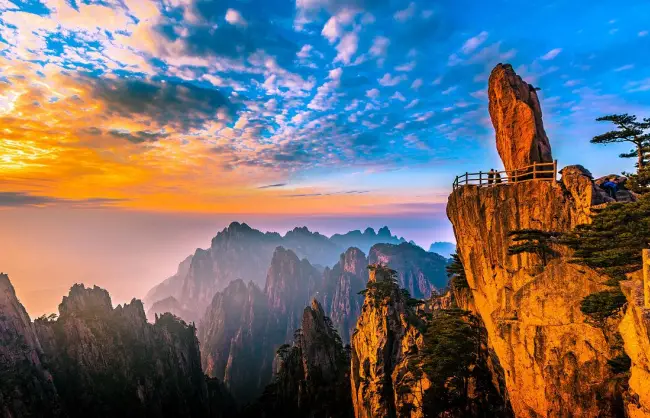
Quick Facts about Mount Huangshan
- Location: in the southern part of Anhui Province, China, about 60 km from Huangshan city center.
- Chinese Name: 黄山 Huángshān
- Best Time to Visit: Suitable to visit year-round; Spring and autumn (April- May, September- October) are especially beautiful
- Altitude: The highest peak is at an elevation of 1,864.8 meters; other peaks are about 1,600-1,860 meters high.
- Highlights: Odd-shaped Pines, spectacular rocks, the sea of clouds, hot springs, stunning sunrise and sunset, exciting hiking and photography experience.
- Transport: About 1.5 hours high-speed train ride from Hangzhou, 2.5 hours from Shanghai.
- Opening Times of Scenic Area: March 2 to November 30: 7:00 AM – 5:10 PM (Monday to Friday), 6:30 AM – 5:40 PM (weekends, public holidays); December 1 to March 1: 8:00 AM – 4:40 PM
- Price of Entrance Ticket:
| Peak Season (Jan. 21st – Dec. 19th) | CNY 190 |
| Winter Season (Dec. 20 th – Jan. 20th) | CNY 150 |
Highlights of Yellow Mountain – More Than the “Four Wonders”
An unparalleled masterpiece of natural and cultural beauty, the Yellow Mountain Scenic Area is known worldwide for its unique landscapes and diverse natural wonders. After visiting Huangshan Mountains, the famous Ming Dynasty explorer Xu Xiake was so moved by its natural beauty and exclaimed, “After climbing Huangshan, no mountain is worth seeing. It is the ultimate marvel.”
The Yellow Mountains Scenic Area is famed for its “Four Wonders”, which are oddly shaped pines, remarkable rock formations, sea of clouds, and millennium-old hot springs. In addition to these wonders, other attractions, like the snowy scenery in winter, magical sunrise and sunset views, and occasional Buddha Light together make Huangshan a mesmerizing destination in China.
Peculiar Pine Trees
Pines on the Yellow Mountain typically thrive in rocky crevices at an altitude above 800 meters. On the northern slopes, they are generally between 1,500-1,700 meters, and 1,000–1,600 meters on the southern slopes.
They stand out for their distinctive shapes and resilience and are given imaginative names based on their appearance.
The over 800-year-old Welcoming Pine (Ying Ke Song) is the most famous and iconic landmark of Huangshan Mountains.
It is located on the east side of Yuping Peak, above Manjusri Cave, at an altitude of approximately 1670 meters. The tree is about 10 meters tall, with one branch extending outward like an enthusiastic host extending an arm to welcome guests from afar, hence its name.

Bizarre Rock Formations
Shaped by geological changes during the Quaternary glacial period, Huangshan’s rock formations appear in countless fascinating shapes. Humans, animals, and mythical creatures, people can see the rock formations change their appearance from different perspective with imagination. Some of the notable formations are as below:
- Flying Rock: Located at the west end of Pingtianqiao, at an altitude of approximately 1730 meters; Stands about 12 meters tall; Due to the minimal contact with the base rock, it seems to float in mid-air.
- Monkey Watching the Sea: Located at the peak of Lion Peak in the Beihai Scenic Area, at an altitude of about 1690 meters; Resembles a monkey sitting and gazing into the sea of clouds, with its forelimbs resting on its knees.
- Ink Brush Blossoms: Located in the Sanhua Valley of the Beihai Scenic Area. The stone peak looks like an inverted brush, with an ancient pine growing at its tip. It appears like a flower blooming from the brush.
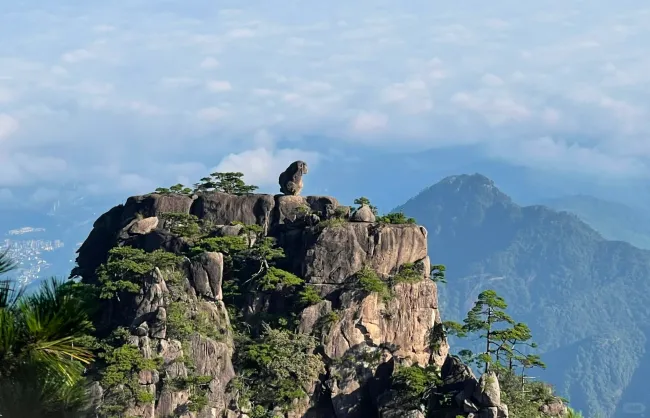
The Sea of Clouds
Yellow Mountains Scenic Area encounters about 200 days of cloudy weather each year, giving rise to its frequent legendary Sea of Clouds. A visual marvel of nature, the Sea of Clouds features vast clouds rolling like waves, creating magical, ever-changing scenery. Embraced by the milky white clouds, the peaks look like floating islands, transforming the scenic area into an ethereal palace suspended between heaven and earth.
Based on the location, the Sea of Clouds of the Yellow Mountain are divided into five major areas.
Some of the best viewing spots for this marvel are:
- Bright Summit: The second-highest peak, Bright Summit is perfect for sunrise and cloud watching.
- Yuping Peak: Located in the South Sea Area. Here, the Welcoming Pine complements the Sea of Clouds, creating one of the most iconic views of the Huangshan Mountains.
- Refreshing Terrace: Located in the North Sea Area. Clouds weave between peaks and pines, creating an ink painting-like landscape.
- Paiyun Pavilion: Located in the West Sea Area. This area features clouds cascading like waterfalls.
Buddha Light
The Buddha Light at Yellow Mountain is a rare atmospheric phenomenon that happens under specific conditions. It is more possible to see when the sun shines through the mist. When the rays of the sun cast a visitor’s shadow onto misty clouds and surround the shadow with a glowing halo, it looks like the halo around a Buddha’s head, hence its name. In strong sunlight, you may witness the Buddha Light displays seven colors, with blue inside and red outside, creating a dazzling effect.
- Timing: According to meteorological data, the Buddha light occurs 40 times a year and is most commonly seen after rain in the early morning or evening.
- Best Spots to Encounter Buddha Light: Front peaks like Lotus Peak, Celestial Capital Peak, Bright Summit, Yuping Peak, and Aoyu Peak, and rear peaks like Shixin Peak, Lion Peak, Flying Rock, Paiyun Pavilion, and the West Sea Grand Canyon.
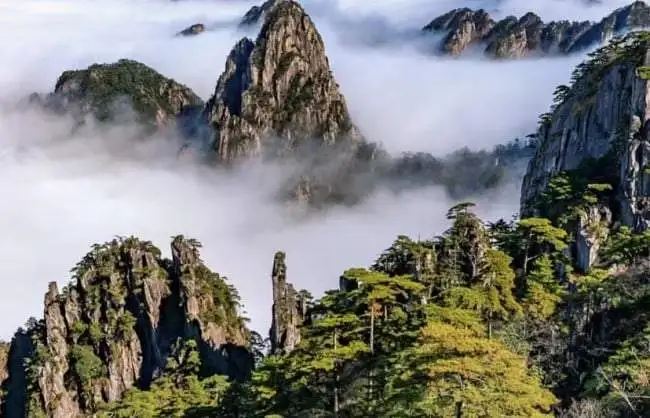
Hot Springs
The water of Huangshan Hot Springs is originated from Purple Cloud Peak, recognized as one of the oldest hot springs in China. They are thought to be beneficial for overall health for maintaining a temperature of around 42°C year-round and being rich in minerals. Legend has it that Emperor Xuanyuan bathed here for 49 days and finally achieved immortality. The hot springs thus are also called “Sacred Springs”. Over the centuries, poets like Li Bai, Jia Dao, and Xu Xiake have left behind poems praising the springs.
At the foot of the mountain, there are many hot spring hotels, offering both indoor and outdoor pools.
Winter Snow
Celebrated as the fifth wonder of Huangshan Mountain, winter snow is one of its most stunning features in winter. The snow-covered peaks, pine trees, and rocks, along with the sea of clouds, create a breathtakingly beautiful masterpiece. Winter snow also brings delicate rime and ice cascades on the branches of trees, decorating the stunning snow scenery with crystalline natural artworks.
Typically, snow occurs from November to March. It is the time when the Yellow Mountain Scenic Area sees fewer tourists, allowing you to enjoy the glassy snowy scenery in peace.
Mesmerizing Sunrise and Sunset Views
A top-tier visual feast, the breathtaking sunrise and sunsets at Yellow Mountain will guarantee you plenty of likes on your social media. They attract countless visitors and photographers every year.
Sunrise Essentials:
- Highlights: See the sun pop out of the sea of clouds, turning the peaks and rocks into shimmering gold. See the cloud sea being transformed into molten gold.
- Best viewing spots: Guangming Ding (central viewpoint with the best visibility), Lion Peak (fewer crowds, equally stunning views), Danxia Peak (a perfect combination of sunrise and sea of clouds).
- Timing: 5:00-5:30 AM in summer, 6:00-6:40 AM in winter. Please check the specific time when you visit.
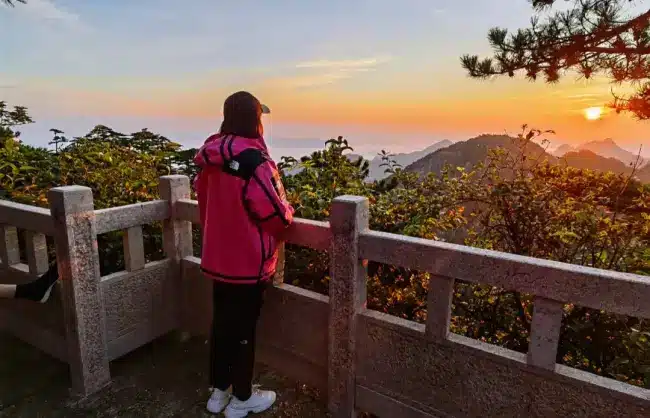
Sunset Essentials:
- Highlights: See the sky transitions from orange-red to pink-purple. Light and shadows flow over the peaks, creating a romantic atmosphere.
- Best viewing spots:Paiyun Pavilion (catch the sunset’s red glow over the West Sea Grand Canyon), Feilai Stone (dramatic silhouette of huge rocks), Aoyu Peak (watch the sun “sink” into the sea of clouds)
- Timing: 18:40-19:00 in summer, 17:00 – 17:30in Please arrive about 0.5-1 hour in advance.
Main Scenic Areas
Front Mountain (Yuping Scenic Area)
- Location: From the South Gate of Huangshan (Ciguang Pavilion) to Yuping Tower
- Main attractions: Welcoming Pine, Yuping Tower (a viewing platform to enjoy the sea of clouds), Lotus Peak (the highest peak in Huangshan Mountains), Tiandu Peak (also a main peak, about 15 minutes walking from Welcoming Pine), and Hundred-Step Cloud Ladder (a steep stone staircase).
- Suggested Visiting Time: 4-6 hours
- Scenic highlights & features: Majestic mountain landscapes, concentrated peculiar pines and rocks, rugged beauty
- How to Get There: Take the shuttle bus from the Huangshan South Gate to Ciguang Pavilion, then ascend via the Yuping Cable Car. Also, you can proceed along the hiking route entrance at Ciguang Pavilion Station.
- Touring route: Ciguang Pavilion – Yuping Cable Car – Welcoming Pine – Yuping Tower – Celestial Capital Peak (Tiandu Peak) – Lotus Peak – Hundred-Step Cloud Ladde. Then, you can descend by Yuping Cable Car or continue hiking to Aoyu Peak and the Bright Summit.
Back Mountain (Beihai–Xihai Scenic Area)
- Location: From Yungu Temple to Paiyun Pavilion. On the eastern side of Yellow Mountain Scenic Area
- Main attractions: Beginning-to-Believe Peak (features peculiar pines and rocks), Lion Peak (a prime spot for watching sunrises and sea of clouds), Monkey Watching the Sea, Qingliang Terrace (Refreshing Terrace, also a great platform for viewing sunrises and the sea of clouds), Bursh Pen Flower.
- Suggested visiting time: Over 4hours
- Scenic highlights & features: Easier hiking and more highlights, graceful mountain scenery, frequent sea of clouds, oddly-shaped pines, and easy access to Bright Summit and West Sea Grand Canyon.
- How to get there: Take the shuttle bus from the South Gate to Yungu Temple, then ascend via the Yungu Cable Car.
West Sea Grand Canyon
- Location: From Paiyun Pavilion to Tianhai. In the northwest part of the Huangshan Scenic Area
- Main attractions: Paiyun Pavilion (the entrance to the West Sea Grand Canyon), Flying-over Stone, Fairy-Walking Bridge, First and Second Ring Trails, small train ( a cable car with transparent cabin, running from the valley floor directly to Tianhainear the Bright Summit).
- Recommended visiting time: 2-5 hours
- Scenic highlights & features: steep canyon, peculiar rocks and sea of clouds, walkways along the edges of the cliffs, thrilling experiences, etc.
- How to get there: Take the shuttle bus from the South Gate to Yungu Temple or Ciguang Pavilion for a cable car ride, then walk to Paiyun Pavilion.
- Recommended touring route: Paiyun Pavilion – 1st ring – 2nd ring – take the small train from the valley to Tianhai in around 5 minutes – Bright Summit. Or a less strenuous route: Paiyun Pavilion – 1st ring – Return to Paiyun Pavilion
Tianhai–Bright Summit Scenic Area (Central Huangshan Mountaintop)
- Location: Central area of Huangshan Mountains
- Main Attractions: Bright Summit (the 2nd highest peak offering great sunrise, sunsets and sea of clouds), Sea Heart Pavilion
- Suggested visiting time: 1-2 hours
- Scenic highlights and features: Open vista, expansive views, core area for sightseeing and photography.
- How to get there: Walk from Baiyun Hotel or Xihai Hotel to Brdight Summit.
Main Cableways on Yellow Mountains
- Yungu Cable Car (Back Mountain Cable Car): Runs from Yungu Temple to White Goose Ridge, with a length of 2,666 meters and an elevation difference of 775 meters. Takes about 8 minutes one way. The terminal at White Goose Ridge is the gateway to the Beihai Scenic Area.
- Yuping Cable Car (Front Mountain Cable Car): Runs from Ciguang Pavilion to Yuping Tower, with a length of 2,176 meters and an elevation difference of 752 meters. Takes about 10 minutes for a single trip.
- Taiping Cable Car (North Gate Cable Car): Runs from Pine Valley Nunnery (Songgu An) to Danxia Peak, with a length of 3,704 meters and an elevation difference of 1,014.5 meters. Takes about 8 minutes for a single trip. The terminal at Danxia Peak is conveniently close to the West Sea Grand Canyon.
- Xihai Grand Canyon Sightseeing Cable Car (the popular small train): Runs from the Stone Bed Peak (Shichuang Peak) to the bottom of the West Sea Grand Canyon, with a length of 892 meters and an elevation difference of 497 meters. Takes about 5 minutes one way. It allows visitors to fully enjoy the stunning vistas and dramatic landscapes of the canyon without a strenuous hike.
Cableway Operating Hours
- March 2nd to November 30th: 7:00 AM – 5:10 PM (Monday to Friday), 6:30 AM – 5:40 PM (weekends, public holidays);
- December 1st to March 1st: 8:00 AM – 4:40 PM
Prices of Cableways (single trip)
| Cloud Valley Cableway | CNY 80 (Jan. 21st – Dec. 19th ); CNY 65 (Dec. 20th – Jan. 20th ) |
| Jade Screen Cableway | CNY 90 (Jan. 21st – Dec. 19th ); CNY 75 (Dec. 20th – Jan. 20th ) |
| West Sea Valley Cableway | CNY 100 (Jan. 21st – Dec. 19th ); CNY 80 (Dec. 20th – Jan. 20th ) |
| Taiping Cableway | CNY 80 (Jan. 21st – Dec. 19th ); CNY 65 (Nov. 20th – Jan. 20th ) |
How to Visit? – Recommended Visiting Routes on the Yellow Mountains
Classic Route for One Day Tour to Huangshan Mountains
Yungu Cable Car – Beginning-to-Believe Peak (Shixin Peak) – Monkey Watching the Sea – Grand King Pine (Dawangsong) – Bright Summit (Guangming Ding) – Flying Stone (Feilai Shi) – West Sea Grand Canyon (Xihai Grand Canyon) – Ride the “Little Train” Up – Aoyu Peak – One-Line Sky (Yixiantian) – Hundred-Step Cloud Ladder – Welcoming Pine – Yuping Cable Car to descend
Also, you can ascend from the Front Mountain and descend from the Back Mountain.
- Recommended Huangshan Mountain One Day Tours:
Mt. Huangshan Day Tour With Round Way Cable Car
Classic 2 Days Yellow Mountain Tour – In-depth Experience Tour of the Yellow Mountains
Day 1: Main Attractions of Back Mountain Area and Xihai Grand Canyon
South Gate – Yungu Temple – Yungu Cable Car – Beginning-to-Believe Peak (Black Tiger Pine and the Couple Pine) – Beihai Scenic Area (enjoy lunch and explore Ink Brush Blossoms, Monkey Watching the Sea, etc. ) – West Sea Grand Canyon – take the Xihai Grand Canyon Sightseeing Cable Car to ascend back.
Good to know:
- In the West Sea Grand Canyon, you can explore the 1st Ring only and hike back in about 1.5 hours, or explore both parts of the 1st Ring and 2nd Ring and take the cable car ascend to Tianhai Station in about 2-2.5 hours.
- Stay overnight at Bright Summit or nearby mountain hotels.
Day 2: Sunrise and Front Mountain Area
Marvel at the sunrise at Bright Summit – Tianhai – Lotus Peak or Celestial Capital Peak (Tiandu Peak) – Welcoming Pine – Yuping Tower – descend via Yuping Cable Car or hiking
- Recommended 2 Days Huangshan Mountain Tours:
2 Days Classic Mount Huangshan Bus Tour
Recommended Huangshan Hiking Route
Day 1: Back Mountain + Beihai Scenic Area
Yungu Temple – White Goose Ridge – Begin to Believe Peak – Lion Peak – Qingliang Terrace (enjoy sunset) – Monkey Watch the Sea. Stay overnight in Beihai Hotel.
Day 2: Xihai Grand Canyon + Bright Summit
Sunrise view at Lion Peak – Paiyun Pavilion – West Sea Grand Canyon hiking – Tianhai – Bright Summit (enjoy sunset). Stay overnight in Baiyun Hotel.
Day 3: Front Mountain Area + Tiandu Peak
Sunrise at Bright Summit – Aoyu Peak – Lotus Peak – Welcoming Pine – Tiandu Peak – Ciguang Pavilion – descend to the mountain foot.
Based on your time, energy, and preferences, you can also choose to hike a section of the above hiking route. Please feel free to contact our travel consultants to customize your Mt. Huangshan hiking route.
Best China Tours including Mt. Huangshan
- 5 Days Shanghai and Huangshan Tour by Bullet Train
- 5 Days Suzhou Huangshan Tour with Water Town and Local Villages
- 6 Days Huangshan and Zhangjiajie Tour with Natural Wonders
- 8 Days East China Tour: Cultural and Scenic Journey
How to Get to the Yellow Mountains
It is convenient to travel to Huangshan City by either flight or high-speed train. After arriving at Huangshan, you can take tourist shuttle buses from Tunxi Bus Station or Huangshan North Railway Station to Mt. Huangshan in about 1 hour. Shuttle buses are also available from Xidi and Hongcun Villages to the scenic area. Also, you can take taxis from the city center to the scenic area in about 1 hour.
Best Times to Visit the Huangshan Mountains
Huangshan Mountain Scenic Area is beautiful year-round, offering unique landscapes and experiences each season. March to May and September to November are the best times to enjoy pleasant weather and beautiful seasonal sceneries, like mountain flowers and frequent sea of clouds in spring and vibrant foliage in autumn. In the winter season, from December to February, you may encounter snow-capped landscapes, catch great photos, and see fewer tourists. The cooler temperature in summer from June to August makes it a great destination to escape the heat, though it is the peak travel season.
Related reading:
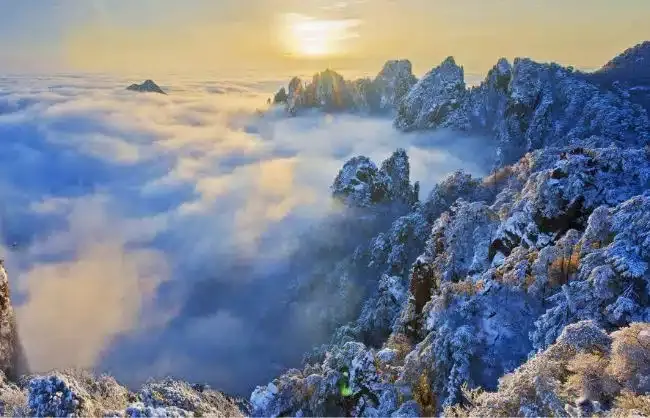
Useful Travel Tips
- Book your entrance tickets and cable car tickets 1-3 days in advance during peak season (March to November).
- Popular hotels on the mountain should be booked 1-2 weeks in advance.
- Bring a light jacket even in summer as the summit would be cool. Other essential items to pack include a backpack, a hiking pole, a raincoat, sunscreen, etc.
- Bring a water bottle and some snacks. Bottled water and food on the summit are expensive.
- Check sunrise and sunset times in advance and secure your spot an hour early.
- The 1st and 2nd rings of the West Sea Grand Canyon walkway are narrow; don’t challenge it if you are afraid of heights.
- Bringing ice cleats is necessary if visiting during the snowy days.
- National holidays, like Golden Week and May Day, will see huge crowds. Try to avoid these periods.
- Certain attractions, like the West Sea Grand Canyon, Celestial Capital Peak, Lotus Peak, and One-line Sky, will be closed in winter for maintenance and safety reasons.
Where to Stay on the Mountain – Recommended Accommodation Areas and Hotels
Baiyun Scenic Area (near Bright Summit)
This is the central area of the scenic area, connecting the front and rear mountains. A great option to catch sunrises and the sea of clouds.
- Recommended hotels: Bright Summit Hotel (you can view the sunrise and sea of clouds from your room; price from USD150 ), Baiyun Hotel (300 meters from Bright Summit, price from USD109)
Beihai Scenic Area (Rear Mountain Area)
This area is near the upper station of the Yungu Cable Car, serving as the starting point for the rear Yellow Mountain tours. It is an ideal place to catch iconic peculiar pines and rocks.
- Recommended hotels: Shilin Hotel (Backed by Lion Peak, a 3-minute walk to Qingliang Terrace – a great place to enjoy sunrise and sea of clouds. Price from USD123), Beihai Hotel (a four-star hotel near Begining-to-Believe Peak, price from USD153).
Xihai Scenic Area (North entrance to the West Sea Grand Canyon)
This area is for those who want a deep exploration of the West Sea Grand Canyon. The nearby Paiyun Pavilion and Danxia Peak offer great sunset views.
- Recommended Hotels: Paiyun Hotel (budget-friendly, with dormitory beds from USD27 and standard rooms around USD109). Xihai Hotel (A five-star hotel with high-end facilities. With standard rooms from USD156. Close to the canyon walkways. )
Yuping Scenic Area (core area of the Front Mountain)
This is the core area of the Front Mountain, near the Yuping Cable Car. Only 500 meters from the iconic Welcoming Pine.
- Recommended hotels: Yupinglou Hotel (The only star-rated hotel in the front mountain area, with standard rooms from around USD127. Offers views of Celestial Capital Peak from your window).









